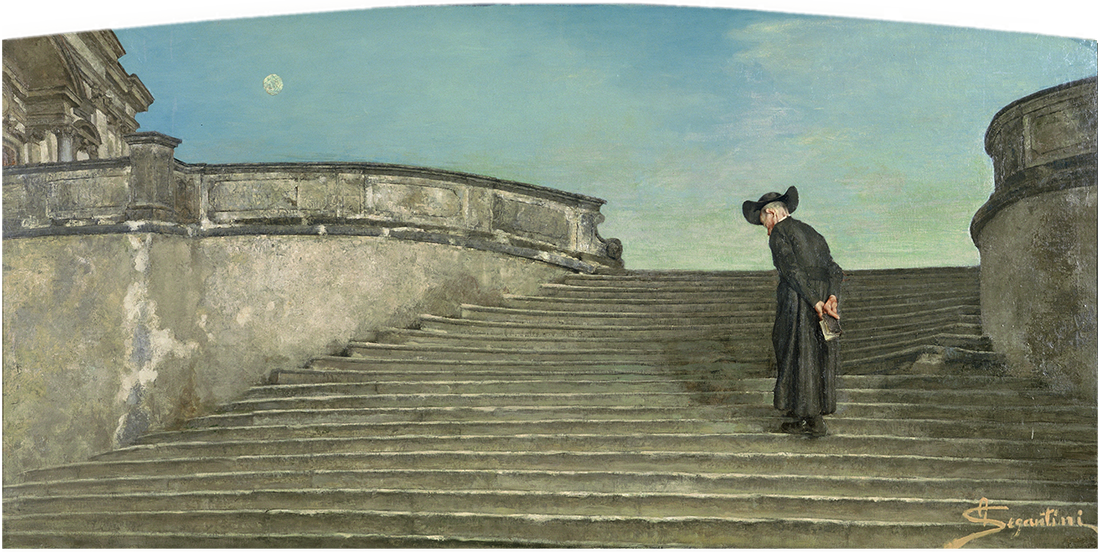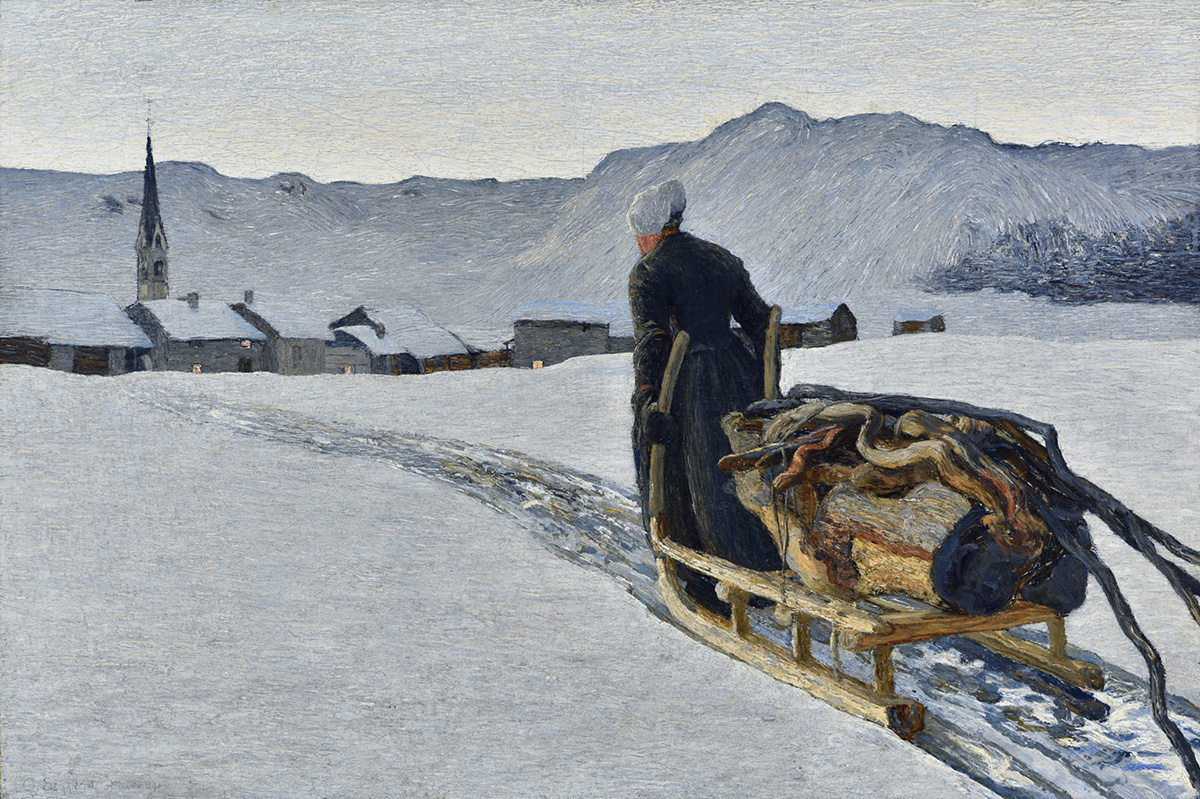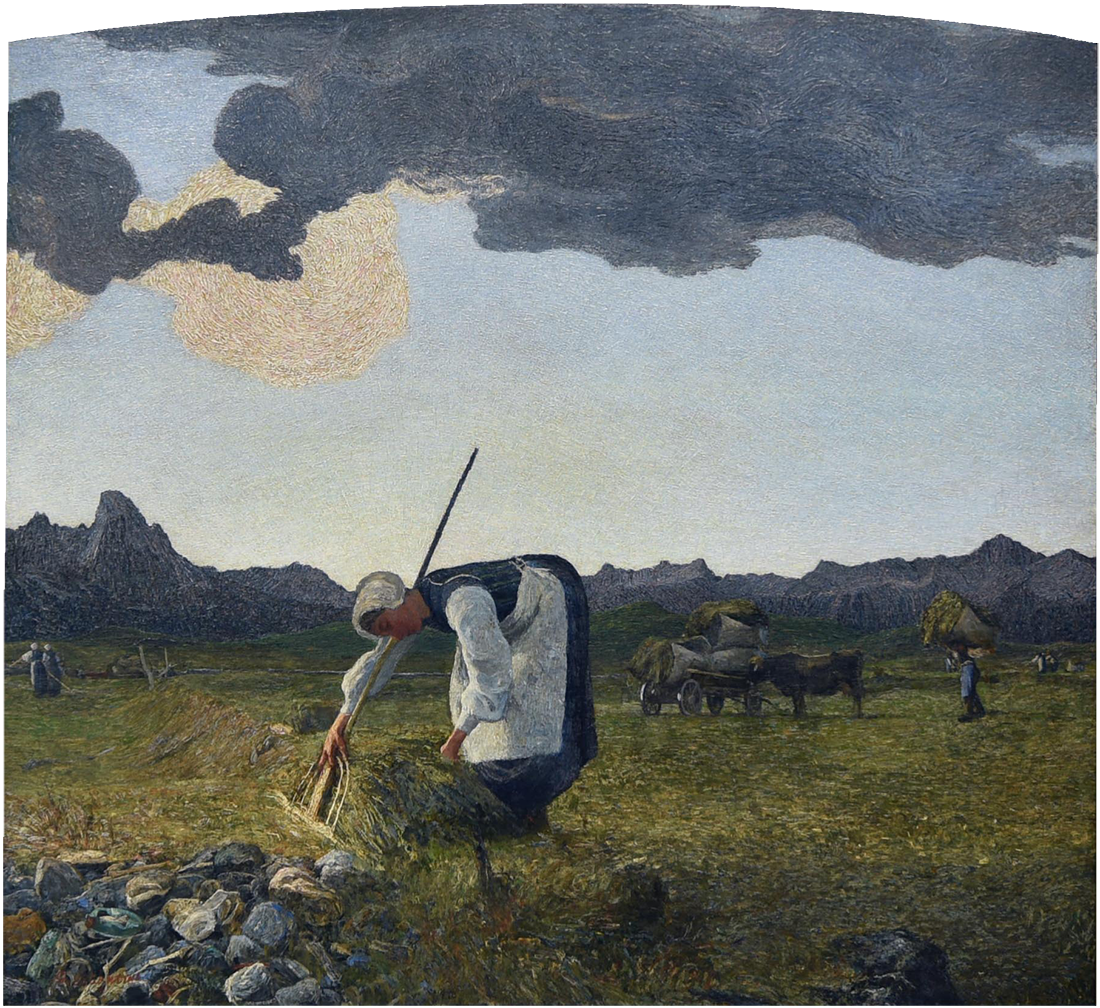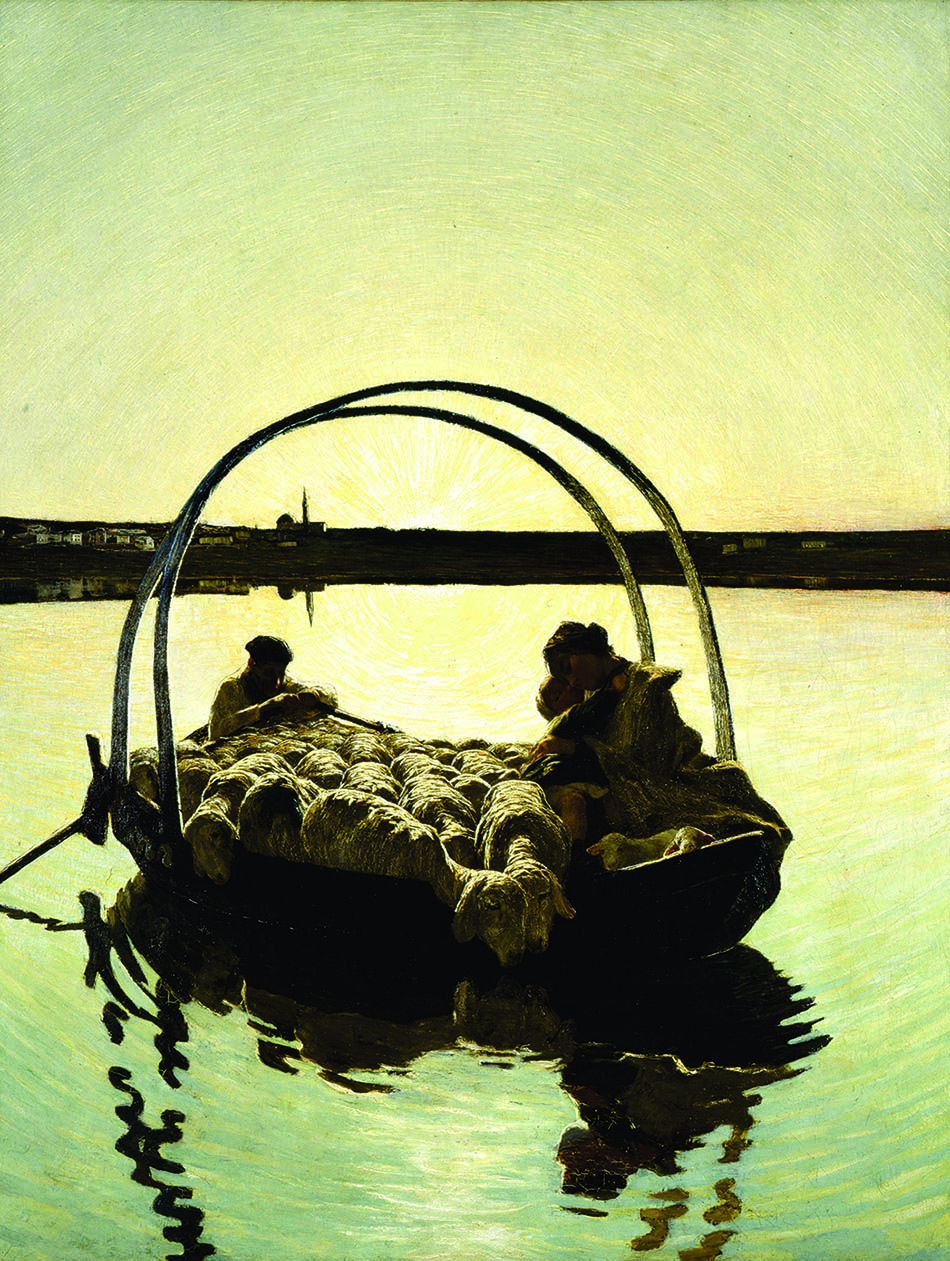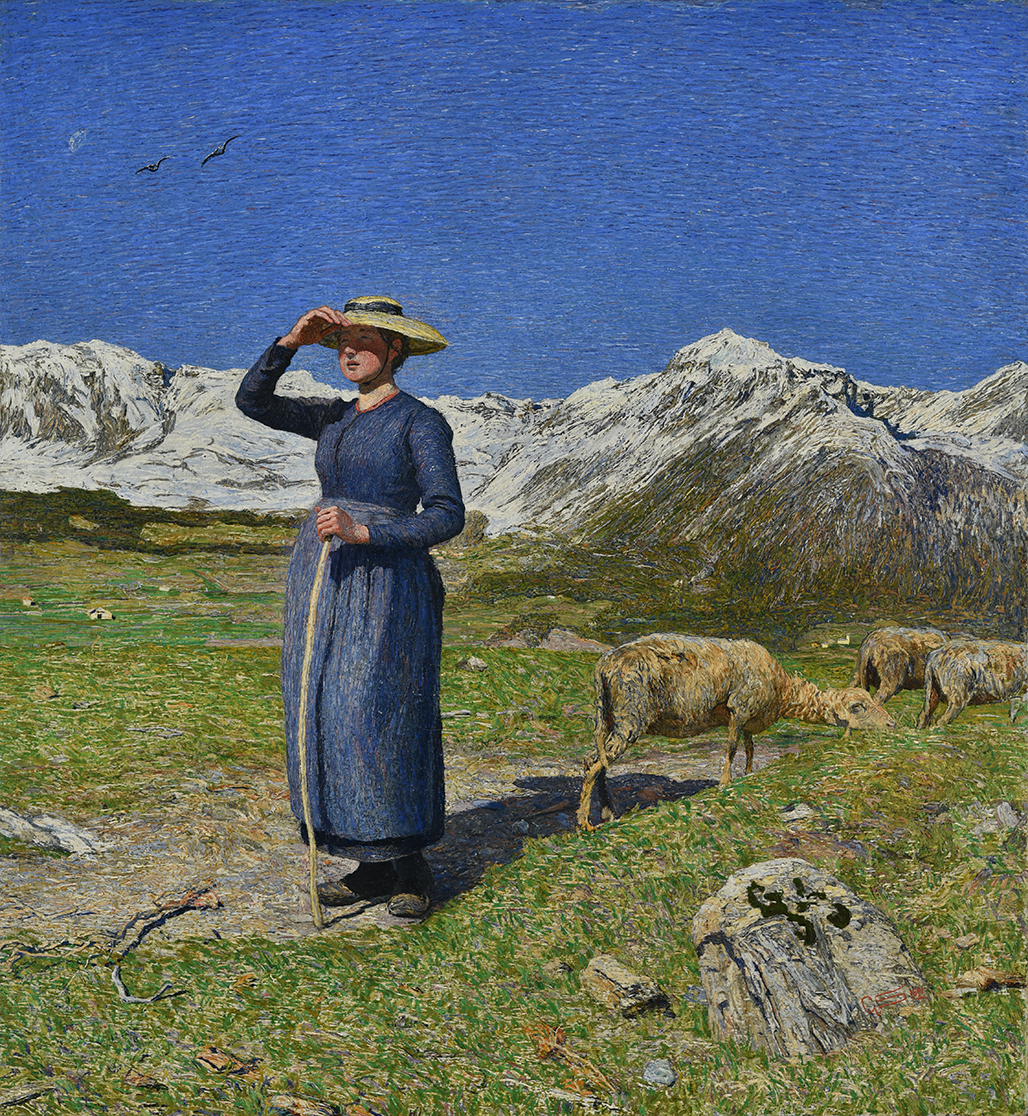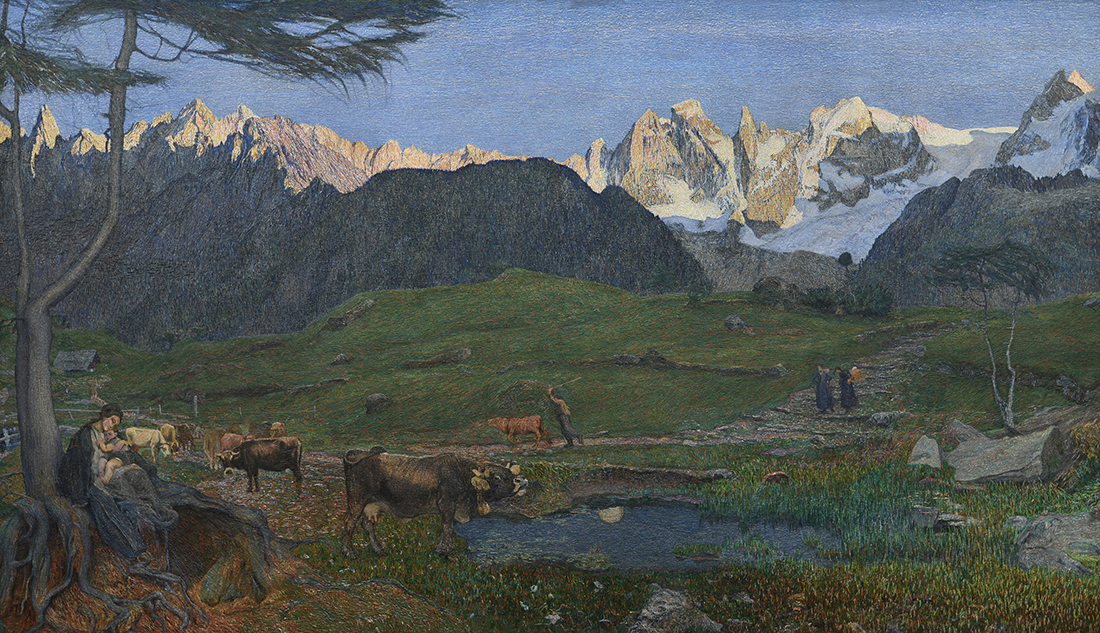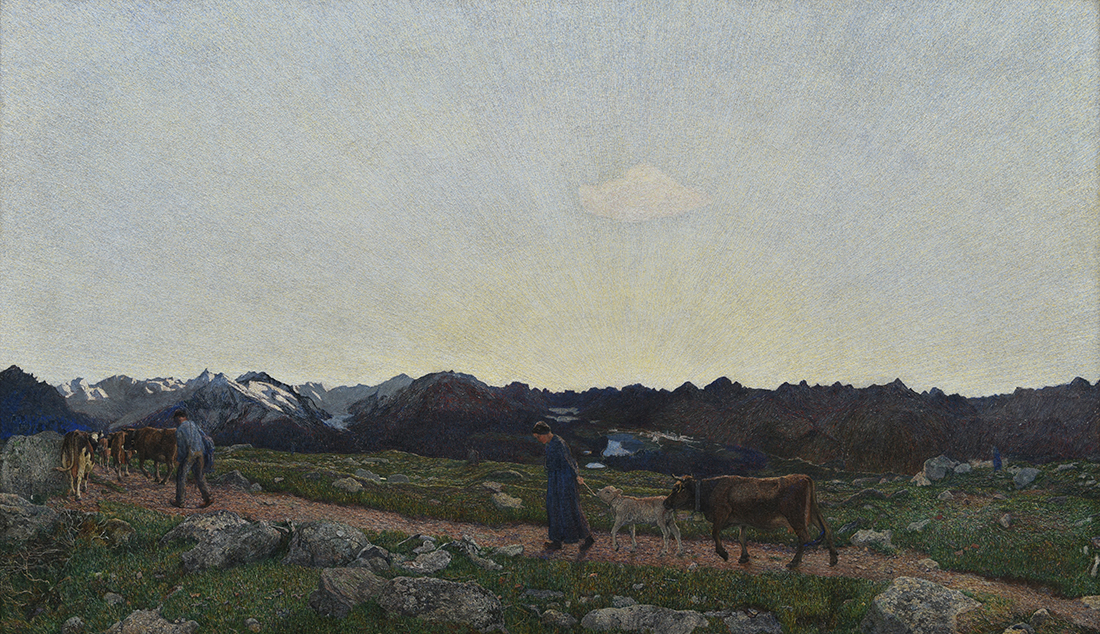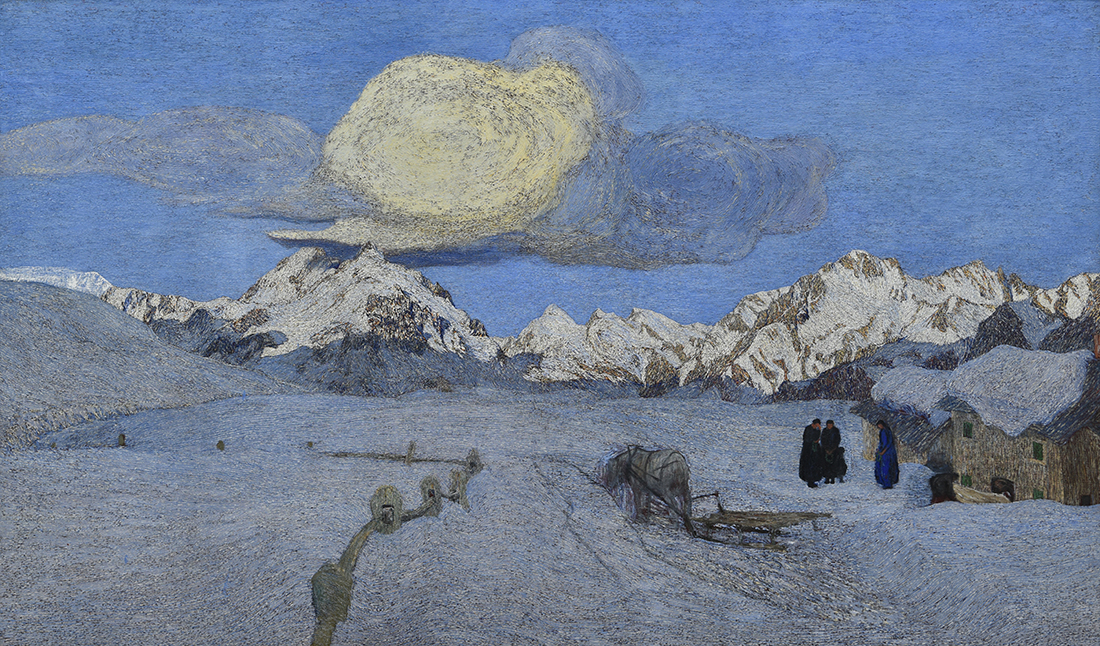Museum
〈 Architecture
〈 Collection
—Highlights
—Paintings
—Drawings
—Works by other artists
〈 Venue hire
〈 Exhibition rooms
Early Mass, 1885
Oil on canvas, 108 x 211 cm
On permanent loan from the Otto Fischbacher Giovanni Segantini Foundation
The focal point of this wide-format painting is the large, sweeping flight of Baroque steps of the church in Veduggio, near Pusiano. The weathered and worn steps lead directly up to the edge of the top step; the transition to the morning sky is extremely abrupt. Only the priest who – lost in thought – climbs the steps, extends above the horizon, thus forming a link between the earthly and the celestial worlds. The flight of steps symbolizes the journey through life, while the pale moon represents the eternal cycle of day and night.
Return from the Wood, 1890
Oil on canvas, 64 x 95.4 cm
On permanent loan from the Otto Fischbacher Giovanni Segantini Foundation
The twilight atmosphere, the bluish-white color of the snow and the leaden sky convey the feeling of a bitterly cold winter evening. A peasant woman heads for home, pulling a sled laden with firewood back to the village. The scene symbolizes the meagre existence of the mountain farmers and their struggle for survival during the severe winter months. The picture is an allegory for life and death, and for the cycle of nature. The tree roots could be a metaphor for new life that is born within the earth, the heavy snow for the mantle of death. The track represents the journey of life and the church tower, with its spire stretching up to the sky, the connection between the earthly and the supernatural.
The Hay Harvest, 1888/1898
Oil on canvas, 137 x 149 cm
On permanent loan from the municipality of St. Moritz, bequest by Adolf Bensinger, Mannheim, 1939
Segantini painted this picture in Savognin in 1888. Ten years later, in Soglio, he added a piece of canvas to the upper edge of the landscape-format picture to form a square. He also added the distant blue line of the mountain range between the meadows and the sky, thus reproducing the mountains of Soglio as a backdrop for a Savognin meadow. Thus, a much larger area was given over to the sky; the dark clouds and the gleaming yellow rays of the sun that has just set have a symbolic meaning. Human activities are depicted under a sky that is both promising and threatening, a sign that people are just as much at the mercy of good as of evil forces.
Ave Maria Crossing the Lake, 1886
Oil on canvas, 121 x 92 cm
On permanent loan from the Otto Fischbacher Giovanni Segantini Foundation
The theme of this picture is the “Ave Maria”, which since the Middle Ages has been the most familiar of all the prayers for intercession to the Virgin Mary and an expression of Catholic devoutness: “Hail Mary, full of grace, the Lord is with you.” The Angelus bell would ring out in the morning, at noon and in the evening, calling the faithful to prayer. The ringing of the church bells from the distant shore summons the couple with their small child in the barque to stop and devote themselves to prayer. The silent devotion takes place outside in the open air, thus transforming the entire surroundings into a place of worship. The idyllic scene is bathed in a halo of light from the bright golden rays of the rising sun, evoking a profoundly tranquil atmosphere.
Midday in the Alps, 1891
Oil on canvas, 78 x 71.5 cm
On permanent loan from the Otto Fischbacher Giovanni Segantini Foundation
The radiant light of the sun, which has reached its zenith at midday, makes the landscape shimmer. In the vibrant blue sky, two birds fly against the wind, which inspired the original title of the painting, “Giornata Ventosa” (Windy Day). The pale crescent moon already points to the night. The figure of the young shepherdess forms a vertical counter pole to the otherwise horizontal layers making up the landscape. The landscape seems more like a scene taken from a much larger picture – a panorama with a figure extending upwards in the center. The shepherdess’s searching gaze into the distance opens up the observer the entire vista.
The Alpine Triptych, 1898
Charcoal and Conté crayon on paper, 137 x 108 cm (outer panels), 137 x 127 cm (middle panel)
On permanent loan from the Foundation for Art, Culture and History, Winterthur
For the 1900 Paris World Exhibition, Giovanni Segantini planned a colossal panorama of the Engadine, a painted panoramic view extending from the Bernina to the Albula massifs. However, the project had to be abandoned due to the high costs. The composition finally ended up as what became known as the Alpine Triptych, depicting the three fundamental concerns of man’s existence: life, nature and death. With his majestic triptych, executed at the end of the 19th century, Giovanni Segantini created one of the last meaningful programmatic pictures of the era. It depicts human existence in perfect harmony with nature. Its simple, rural figures are embedded in the transition between day and night, in the perpetual cycle of the seasons, between birth and death. The imposing panorama of Alpine scenery gives rise to a pantheistic vision of extraordinary figurative impact and profoundly symbolic intrinsic value.
Life (La vita), 1896–1899
Oil on canvas, 192.5 x 321.5 cm
On permanent loan from the Gottfried Keller Foundation
The landscape shows the view from Soglio towards the opposite side of the valley, with the Sciora mountain range and the Bondasca Glacier in the background. The last rays of the evening sun fall on the mountain peaks. The foreground is already in deep shadow, the rising moon is reflected in the small pond in the middle of the picture. A young woman with a child sits amidst the roots of a large tree in the center of the scene, a herdsman uses his stick to drive a calf back towards the herd, while on the right, two women carrying their infants in cradles on their backs make their way down a stepped path. According to Segantini, the scene portrays “the life of all things that have their roots in Mother Earth”.
Nature (La natura), 1897–1899
Oil on canvas, 236 x 402.5 cm
On permanent loan from the Gottfried Keller Foundation
The low, regular horizon divides the earth and sky. The last rays of the sun, which has just set behind the mountains, fan out across the broad expanse of sky, flooding it with light. They lend a reverential atmosphere to the quiet, peaceful scene of a day’s work almost done. In the foreground, a peasant couple are driving their cows and calf along the mountain path back home to their shed. The view extends from the Schafberg, high above Pontresina, to the ring of mountains and far into the valley to the lakes and the houses of St. Moritz.
Death (La morte), 1896–1899
Oil on canvas, 192.5 x 321.5 cm
On permanent loan from the Gottfried Keller Foundation
According to Segantini, this picture is intended to portray “the apparent death of all things”. The theme of death is underscored by the choice of season. In the snow-laden Maloja landscape, looking towards the Val Maroz in the Bregaglia region, mourning women and a child wait as a corpse, wrapped in a linen shroud, is carried out of the house. A horse harnessed to a sled stands ready to take the body to the cemetery. The morning sun has just risen above the mountains and shines on a fantastic, mysteriously visionary bank of cloud, alluding to a celestial presence and new life after death.

